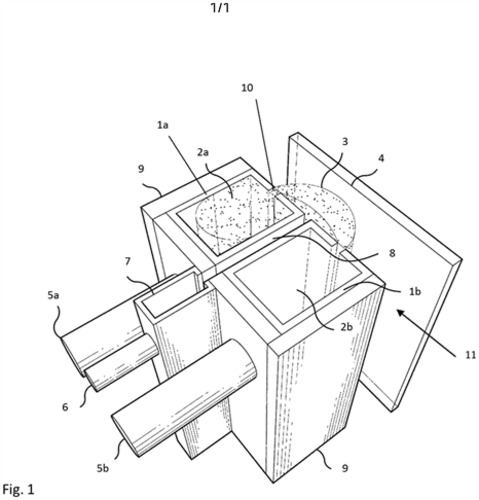Applicant: AGC Glass Europe
Inventor: ARNOULT GRÉGORY
Patent number: WO2021/058547
Hydrophobic coatings based on fluorinated hydrocarbons are well-known for waterproofing fabric substrates but have been found to be problematic from an ecological point of view. Carbon-based coatings also provide a certain level of hydrophobicity and can be produced by using plasma enhanced chemical vapor deposition (PECVD) methods when coating certain fabric substrates for various coating materials. The coating of fabric substrates presents an additional difficulty of coating throughout the three-dimensional structure of the fabric substrate. Frequent issues encountered when coating fabric substrates include: the increase of the fabric substrate temperature and the melting or burning of the fabric fibers. This may limit the applicability of certain coating techniques to certain fibers with sufficiently high temperature resistance and/or this may lead to additional cooling being required during coating.
A general issue with coating fabric substrates, in particular substrates based on synthetic, polymeric fibers, is the low adhesion of functional coatings such as hydrophobic coatings on these fibers. Pre-treatments or surface activation processes, by wet chemistry or plasma techniques have been described. While in many ways effective, these treatments may structurally weaken the textile fibers or in the case of plasma treatments, lead to the melting or burning of the fibers. Furthermore, adhesion of carbon-based coatings, in particular when they contain significant amounts of sp3 hybridized carbon, is particularly challenging.
How did AGC Glass Europe solve the problem?
One of the objectives of the present invention is to provide hydrophobic carbon-based coatings on fabric substrates by the use of a low-pressure hollow cathode plasma enhanced chemical vapor deposition (PECVD) process, which pressure is for the present application between 0.005 and 0.050 Torr in the process chamber. Carbon-based hydrophobic coatings may make fabric substrates waterproof, reducing or even eliminating the absorption or wicking of water by the fabric substrates. They may also provide coated fabric substrates with resistance against mechanical wear.
Additional objectives of the present invention are
- to provide such a hydrophobic carbon-based coating which show high-adhesion to fabric substrates and has high-mechanical wear resistance.
- to provide a simple process for depositing hydrophobic carbon-based coatings on fabric substrates, in particular showing high adhesion, and high abrasion wear resistance.
The invention relates to a production process of hydrophobic carbon-based coating on fabric substrates comprising the stages consisting in:
- Providing a fabric substrate;
- Providing a first plasma source, of linear hollow-cathode type, comprising at least one pair of hollow-cathode plasma generating electrodes connected to an AC, DC or pulsed DC generator, for the deposition of said carbon-based coating on the fabric substrate;
- Injecting a first plasma generating gas in the first plasma source’s electrodes at a flow rate of between 1500 and 4500 seem per linearmeter of plasma of the first plasma source;
- Applying a first electrical power to the first plasma source, so that the first power density of the plasma is between 4 kW and 15 kW per linear meter of plasma of the first plasma source;
- Injecting a gaseous precursor of carbon at a flow rate of between 100 and 500 seem per linear meter of plasma of the first plasma source, the gaseous precursor being injected into the plasma in at least between the electrodes of each electrode pair of the first plasma source;
- Depositing a carbon-based coating on the fabric substrate’s surface by exposing the fabric substrate to the plasma of the first plasma source.
In certain embodiments of the present invention
- the carbon precursor gas may be a hydrocarbon gas, for example selected among ChU, C2H4, C2H2, C3H8, C4H10. In certain advantageous embodiments the carbon precursor gas is CH4.
- one or more dopant precursor gases are injected in between the electrodes of each electrode pair of the first plasma source, so as to deposit a doped carbon based coating. The dopant gases may be selected among gases containing W, Ti, Si, 0, N, B. In certain advantageous embodiments, the dopant gas contains Si. In certain advantageous embodiments the dopant gas is SihU, 1 ,1 ,3,3-tetramethyl disiloxane (TMDSO), or hexamethyl disiloxane (HMDSO).
Additionally, fabric substrates useful in the present invention can include fabric substrates that have fibers that can be natural and/or synthetic. It is notable that the term "fabric substrate" does not include materials commonly known as any kind of paper (even though paper can include multiple types of natural and synthetic fibers or mixture of both types of fibers). Furthermore, fabric substrates include both textiles in its filament form, in the form of fabric material, or even in the form of fabric that has been crafted into finished article (clothing, blankets, tablecloths, napkins, bedding material, curtains, carpet, shoes, etc.). In some examples, the fabric substrate has a woven, knitted, non-woven, or tufted fabric structure.
FIG. 1 shows a plasma source, of hollow cathode type for use in the present invention which contains one pair of electrodes





